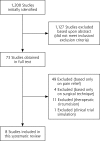Safety and efficacy of nontherapeutic male circumcision: a systematic review
- PMID: 20065281
- PMCID: PMC2807391
- DOI: 10.1370/afm.1073
Safety and efficacy of nontherapeutic male circumcision: a systematic review
Abstract
Purpose: We wanted to assess the safety and efficacy of nontherapeutic male circumcision through a systematic review of the literature.
Methods: We systematically searched The York Centre for Reviews and Disseminations, Cochrane Library, PubMed, and EMBASE databases for randomized controlled trials published between January 1997 and August 2008. Studies reporting on circumcision in an operative setting in males of any age with no contraindications to or medical indications for circumcision were eligible for inclusion. The main comparator was intact genitalia. From 73 retrieved studies, 8 randomized controlled trials were ultimately included for analysis.
Results: Severe complications were uncommon. Analgesia/anesthesia during circumcision was promoted. The prevalence of self-reported genital ulcers was significantly lower in circumcised men than uncircumcised men (3.1% vs 5.8%; prevalence risk ratio 0.53; 95% confidence interval [CI], 0.43-0.64; P<.001). Circumcised sub-Saharan African men were at significantly lower risk of acquiring human immunodeficiency virus/acquired immune deficiency syndrome than were uncircumcised men (random effects odds ratio = 0.44, 95% CI, 0.32-0.59; P <.001). The evidence suggests that adult circumcision does not affect sexual satisfaction and function.
Conclusions: Strong evidence suggests circumcision can prevent human immunodeficiency virus/acquired immune deficiency syndrome acquisition in sub-Saharan African men. These findings remain uncertain in men residing in other countries. The role of adult nontherapeutic male circumcision in preventing sexually transmitted infections, urinary tract infections, and penile cancer remains unclear. Current evidence fails to recommend widespread neonatal circumcision for these purposes.
Figures
Similar articles
-
Male circumcision for prevention of heterosexual acquisition of HIV in men.Cochrane Database Syst Rev. 2003;(3):CD003362. doi: 10.1002/14651858.CD003362. Cochrane Database Syst Rev. 2003. Update in: Cochrane Database Syst Rev. 2009 Apr 15;(2):CD003362. doi: 10.1002/14651858.CD003362.pub2. PMID: 12917962 Updated.
-
Male circumcision for prevention of heterosexual acquisition of HIV in men.Cochrane Database Syst Rev. 2009 Apr 15;2009(2):CD003362. doi: 10.1002/14651858.CD003362.pub2. Cochrane Database Syst Rev. 2009. PMID: 19370585 Free PMC article.
-
Population-based interventions for reducing sexually transmitted infections, including HIV infection.Cochrane Database Syst Rev. 2004;(2):CD001220. doi: 10.1002/14651858.CD001220.pub2. Cochrane Database Syst Rev. 2004. Update in: Cochrane Database Syst Rev. 2011 Mar 16;(3):CD001220. doi: 10.1002/14651858.CD001220.pub3. PMID: 15106156 Updated.
-
Population-based biomedical sexually transmitted infection control interventions for reducing HIV infection.Cochrane Database Syst Rev. 2011 Mar 16;(3):CD001220. doi: 10.1002/14651858.CD001220.pub3. Cochrane Database Syst Rev. 2011. PMID: 21412869
-
School-based interventions for preventing HIV, sexually transmitted infections, and pregnancy in adolescents.Cochrane Database Syst Rev. 2016 Nov 8;11(11):CD006417. doi: 10.1002/14651858.CD006417.pub3. Cochrane Database Syst Rev. 2016. PMID: 27824221 Free PMC article.
Cited by
-
Male circumcision performed with 8-figure non-absorbable suture technique.Can Urol Assoc J. 2014 Mar-Apr;8(3-4):E142-7. doi: 10.5489/cuaj.1521. Can Urol Assoc J. 2014. PMID: 24678353 Free PMC article.
-
Determination and evaluation of HR-HPV genotype in different communities of Bihar, India.Int J Health Sci (Qassim). 2022 Sep-Oct;16(5):40-48. Int J Health Sci (Qassim). 2022. PMID: 36101850 Free PMC article.
-
Circumcision in hemophilia using low quantity of factor concentrates: experience from Dakar, Senegal.BMC Hematol. 2017 Apr 24;17:8. doi: 10.1186/s12878-017-0080-1. eCollection 2017. BMC Hematol. 2017. PMID: 28451435 Free PMC article.
-
Canadian Urological Association guideline on the care of the normal foreskin and neonatal circumcision in Canadian infants (abridged version).Can Urol Assoc J. 2018 Feb;12(2):18-28. doi: 10.5489/cuaj.5034. Epub 2017 Dec 1. Can Urol Assoc J. 2018. PMID: 29381455 Free PMC article. No abstract available.
-
Canadian Urological Association guideline on the care of the normal foreskin and neonatal circumcision in Canadian infants (full version).Can Urol Assoc J. 2018 Feb;12(2):E76-E99. doi: 10.5489/cuaj.5033. Epub 2017 Dec 1. Can Urol Assoc J. 2018. PMID: 29381458 Free PMC article. No abstract available.
References
-
- Godbole P, Duffy P, Boddy S-A, et al. Management of foreskin conditions [monograph on the Internet]. London: British Association of Paediatric Urologists; 2007. [cited 2008 Aug 25]. http://www.baps.org.uk/documents/circumcision2007.pdf.
-
- Cold CJ, Taylor JR. The prepuce. Br J Urol. 1999;83(Suppl 1):34–44. - PubMed
-
- Alanis MC, Lucidi RS. Neonatal circumcision: a review of the world’s oldest and most controversial operation. Obstet Gynecol Surv. 2004;59(5):379–395. - PubMed
-
- Lerman SE, Liao JC. Neonatal circumcision. Pediatr Clin North Am. 2001;48(6):1539–1557. - PubMed
-
- Williams N, Kapila L. Complications of circumcision. Br J Surg. 1993;80(10):1231–1236. - PubMed
Publication types
MeSH terms
LinkOut - more resources
Full Text Sources
Other Literature Sources
Medical


